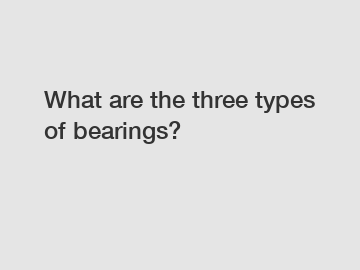When it comes to machinery and equipment, bearings play a crucial role in ensuring smooth operation and reducing friction. Bearings are used in a wide range of applications, from automotive to industrial machinery, and they come in various types to suit different needs and requirements. In this blog post, we will explore the three main types of bearings and their unique characteristics.
1. Ball Bearings: Ball bearings are one of the most common types of bearings used in various applications. They consist of small metal balls that are housed in a ring or raceway. The balls roll between the inner and outer raceways, allowing for smooth rotation and reducing friction. Ball bearings are known for their high speed capabilities and are used in applications where high rotational speeds are required, such as in automotive engines, conveyor belts, and electric motors.
One of the key advantages of ball bearings is their ability to handle both radial and thrust loads, making them versatile and suitable for a wide range of applications. They are also relatively easy to install and maintain, making them a popular choice among engineers and designers.

2. Roller Bearings: Roller bearings are another common type of bearings that are used in various applications. Unlike ball bearings, roller bearings use cylindrical rollers instead of balls to reduce friction and allow for smooth rotation. Roller bearings are known for their high load-carrying capacity and are used in applications where heavy loads need to be supported, such as in heavy machinery, construction equipment, and large industrial gears.
There are several types of roller bearings, including cylindrical roller bearings, tapered roller bearings, and spherical roller bearings. Each type has its own unique design and characteristics, making them suitable for different applications and environments. Roller bearings are known for their durability and long service life, making them a reliable choice for demanding applications.
3. Plain Bearings: Plain bearings, also known as sleeve bearings or bushings, are a type of bearings that do not contain any rolling elements. Instead, plain bearings rely on a sliding motion between two surfaces to reduce friction and allow for smooth operation. Plain bearings are commonly used in applications where low friction and simplicity are more important than high precision and speed.
Plain bearings are often made of materials such as bronze, nylon, or Teflon, which provide excellent wear resistance and self-lubricating properties. They are used in a wide range of applications, from household appliances to industrial machinery, and are known for their low cost and easy installation.
In conclusion, bearings are an essential component of machinery and equipment, and understanding the different types of bearings can help engineers and designers choose the right type for their specific needs. Whether it's a ball bearing for high speed applications, a roller bearing for heavy loads, or a plain bearing for low friction requirements, there is a type of bearing to suit every application. By choosing the right type of bearing, engineers can ensure smooth operation, reduced friction, and improved efficiency in their designs.
If you are looking for more details, kindly visit what causes throw out bearing failure, china tensioner bearing factory, throw-out bearing failure symptoms.


Comments
Please Join Us to post.
0